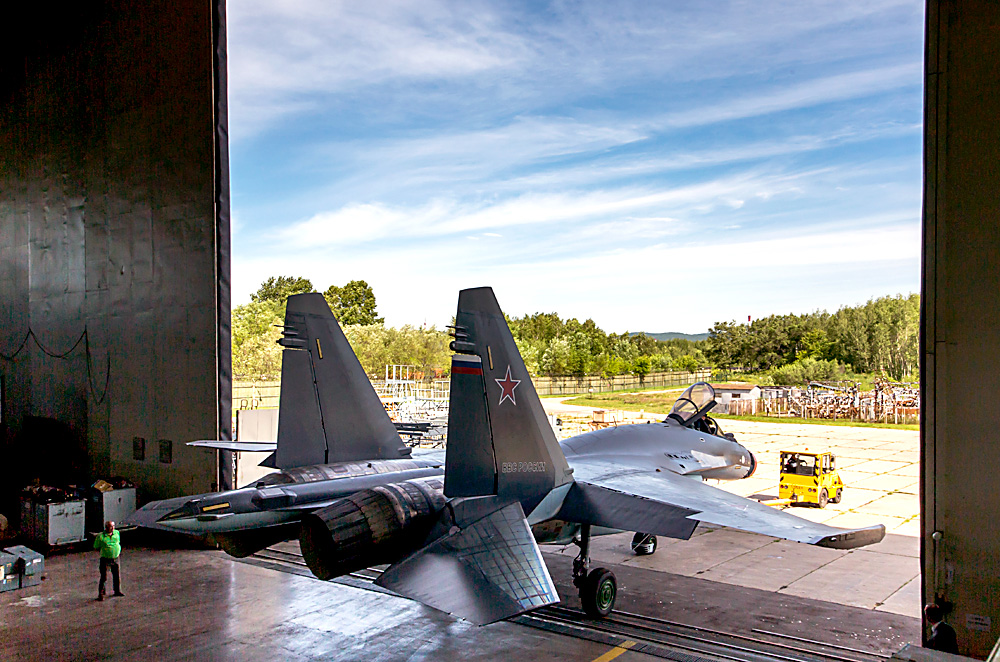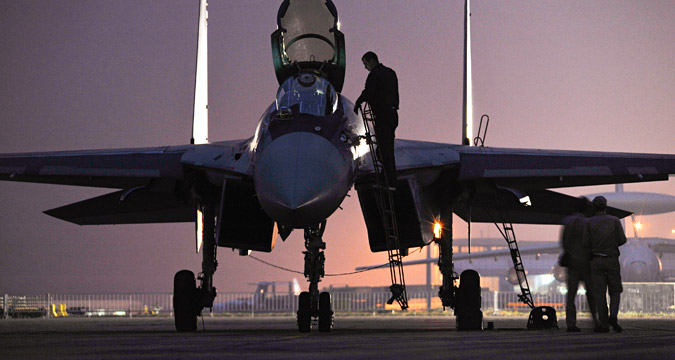
A Sukhoi-35 fighter being assembled in a workshop at the Gagarin Aircraft Manufacturing Enterprise in Komsomolsk-on-Amur.
Marina Lystseva/TASSThe Sukhoi Su-35 will be the lynchpin of Indonesia’s mission to build a modern defence force. Codenamed Super Flanker by NATO, this Russian heavyweight is a perfect fit for Indonesia’s geography. It finally solves the country’s long-standing problem of having to defend a 5000 km archipelago with an under strength military.
The Su-35 has a range of 3600 km on internal fuel, which will allow the Indonesian Air Force to undertake missions far away from home. Because the vast country of 18,370 islands has an underdeveloped network of airfields, the Indonesian Air Force cannot disperse its air force. With its long legs, the Su-35 eliminates this problem.
The Indonesian Air Force will be able to patrol a larger area for a longer duration. The aircraft is equipped with an aerial refuelling probe which can extend its reach as well as loiter time. The Indian Air Force, which trains Indonesian fighter pilots, has conducted 10-hour Sukhoi missions so in theory the Indonesians can do the same.
 Mad MAKS: International Aerospace Show demonstrates Russia’s state-of-the-art military aircraft
Mad MAKS: International Aerospace Show demonstrates Russia’s state-of-the-art military aircraft
For an aircraft that carries an enormous payload – 8 tonnes of missiles and bombs on 14 hard points – it is a fast aircraft. Its blistering speed – combined with long range – allows pilots to perform repeated probes and U-turns – a Cold War Russian tactic – that can leave the opponent disoriented, exhausted and vulnerable in a dogfight.
A defining feature of Russian fighter aircraft is they come with a large complement of missiles. (Those 14 hard points aren’t for display.) This is a huge advantage for pilots because they can carry more missiles and thereby fire repeated salvos to achieve an air-to-air kill.
The Russians have sold missiles of considerable accuracy and kinetic impact to a number of customers and it is very likely the Indonesian Su-35s will come with such missiles. Extended range Russian land attack and anti-ship missiles will allow the Indonesian Sukhois to attack targets from safe standoff distances. The Su-35, therefore, eliminates the tyranny of distance. Places on the maps – such as Darwin and Perth – that once seemed unreachable are now firmly in the Indonesian Air Force’s sights.
The Indonesian military’s weakness was exposed most glaringly during the East Timor crisis. In 1999 it could only watch from the sidelines as a contingent of largely Australian troops prised East Timor from Indonesian control. That it happened under a UN mandate did nothing to lessen Indonesia’s humiliation.
Continuing economic weakness meant Indonesia was only able to drip feed its military. After American sanctions virtually grounded its fleet of anyhow outdated F-16s, Indonesia ordered two Su-27 single-seat and two Su-30 twin-seat fighters from Russia in a 2003 contract worth $192 million. Four years later, it ordered six more Sukhois. Defence analyst Martin Sieff describes the deals as “peanuts in the international arms trade”.
The upshot: with its existing fleet the Indonesian Air Force cannot take on regional rivals. For instance, the Royal Australian Air Force has 69 F/A-18 Hornets and 24 advanced Super Hornets. Australia also has the EA-18G Growler electronic warfare aircraft, which can be a force multiplier in any conflict. Also, the Australian air force, which loves to follow in America’s slipstream, has some combat experience, even if such action involves pretend airstrikes against ISIS.
The Su-35 is a morale booster for the Indonesians as it will considerably even the odds in the South East Asian theatre. The aircraft has a highly advanced avionics suite that can burn through any electronic jamming and can blind enemy aircraft with its own jamming devices. Most western analysts agree the Su-35 is the most potent non-stealth aircraft in the world today and can defeat any contemporary western fighter, except the F-22 stealth fighter. (But then the F-22 costs an astronomical $350 million per plane compared with the Su-35’s bargain basement price of $65 million.)
China is the other worry. Jakarta has been involved in a regional scrap with Beijing over disputed islands in the South China Sea. The Indonesians may never be able to match China’s firepower, but with the Su-35 the Indonesian Air Force will have the ability and confidence to escort Chinese jets over neutral waters.
Although their effectiveness is being debated, it is likely that by the 2020s the new breed of stealth jets will be a regular feature in all the major air forces of the world. In Asia, the Chinese have commenced series production of their J-31 and J-21 stealth fighters, and the Australians have ordered 70 F-35s from the US.
How is Indonesia placed in an incoming stealth environment? The Indonesian Air Force had initially indicated it was interested in the Russia-India PAK-FA multirole fighter. Later it joined South Korea as a junior partner to jointly develop the Korean Fighter-Experimental (KFX). But things haven’t worked out as planned.
Like every ongoing stealth fighter in the world today, the costly KFX project has hit turbulence. According to Forbes magazine, the US doesn’t trust the South Koreans with four “core technologies” needed for the project. It adds: “The Koreans have professed bitter disappointment over the refusal of the US to entrust its ally with the highest-tech stuff they say is needed for the KFX not only to have stealth capabilities but to be able to find and track hostile targets with the latest state-of-the-art radar.”
The Su-35 is Indonesia’s insurance against the KFX getting delayed or abandoned. Yang Cheng-wei, a Taiwanese expert on Russian weapons systems, describes the aircraft as a “fifth generation jet without the appearance of a stealth fighter." In fact, it incorporates several futuristic technologies that were developed for Russia’s PAK-FA stealth fighter.
An August 2015 report by the US-based National Security Network (NSN) indicates the Su-35 could club the F-35 to death in a one-on-one dogfight. In ‘Thunder without Lightning: The High Costs and Limited Benefits of the F-35 Program’, the think tank’s policy analyst Bill French and researcher Daniel Edgren say the F-35 is likely to be “outmaneuvered” and “outgunned” by its “near peers” such as the Su-35.
“Perhaps more significant than counter-stealth radar is the F-35’s vulnerability to detection by infrared sensors. Infrared search-and-track (IRST) systems, which are widely deployed on foreign fighter aircraft, can detect aircraft otherwise invisible to radar at significant distances without emitting any signal of their own.”
Nodding to IRST technology’s implications in bypassing radar stealth, Chief of Naval Operations Admiral Jonathan Greenert told NSN: “Let's face it, if something moves fast through the air, disrupts molecules and puts out heat—I don't care how cool the engine can be, it's going to be detectable.”
“The F-35 will be particularly vulnerable to IRST detection given its enormous engine that puts out 40,000 lbs of thrust with no infrared shielding or suppression. Already, the OLS-35 IRST featured on the Su-35 can detect aircraft from the frontal aspect at nearly 30 nautical miles, from the rear at 50 nautical miles, and missile launches at similar distances.”
The Su-35 is, therefore, a future proof aircraft that will be able to take on advanced fifth generation without working up a sweat. According to Defense Industry Daily, if Indonesia decides to stay the course with the KFX, “the country needs a high-end gap filler as a hedge against the KFX’s schedule, and its development risks.”
Alternatively, if the Russians are able to once again get Jakarta interested in the PAK-FA programme, then the Super Flanker can be Indonesia’s final bridge to the stealth era.
Rakesh Krishnan Simha is a New Zealand-based journalist and foreign affairs analyst, with a special interest in defence and military history. He is on the advisory board of Modern Diplomacy, a Europe-based foreign affairs portal. He tweets at @simharakesh. The views expressed here are the author’s own and do not necessarily reflect those of RBTH.
All rights reserved by Rossiyskaya Gazeta.
Subscribe
to our newsletter!
Get the week's best stories straight to your inbox